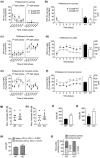Diabetes type 2 risk gene Dusp8 is associated with altered sucrose reward behavior in mice and humans
- PMID: 33131190
- PMCID: PMC7821601
- DOI: 10.1002/brb3.1928
Diabetes type 2 risk gene Dusp8 is associated with altered sucrose reward behavior in mice and humans
Abstract
Background: Dusp8 is the first GWAS-identified gene that is predominantly expressed in the brain and has previously been linked with the development of diabetes type 2 in humans. In this study, we unravel how Dusp8 is involved in the regulation of sucrose reward behavior.
Methods: Female, chow-fed global Dusp8 WT and KO mice were tested in an observer-independent IntelliCage setup for self-administrative sucrose consumption and preference followed by a progressive ratio task with restricted sucrose access to monitor seeking and motivation behavior. Sixty-three human carriers of the major C and minor T allele of DUSP8 SNP rs2334499 were tested for their perception of food cues by collecting a rating score for sweet versus savory high caloric food.
Results: Dusp8 KO mice showed a comparable preference for sucrose, but consumed more sucrose compared to WT mice. In a progressive ratio task, Dusp8 KO females switched to a "trial and error" strategy to find sucrose while control Dusp8 WT mice kept their previously established seeking pattern. Nonetheless, the overall motivation to consume sucrose, and the levels of dopaminergic neurons in the brain areas NAcc and VTA were comparable between genotypes. Diabetes-risk allele carriers of DUSP8 SNP rs2334499 preferred sweet high caloric food compared to the major allele carriers, rating scores for savory food remained comparable between groups.
Conclusion: Our data suggest a novel role for Dusp8 in the perception of sweet high caloric food as well as in the control of sucrose consumption and foraging in mice and humans.
Keywords: Dusp8; MAP kinase; dopamine; sucrose reward.
© 2020 The Authors. Brain and Behavior published by Wiley Periodicals LLC.
Conflict of interest statement
Dr. Matthias Tschöp is a member of the scientific advisory board of ERX Pharmaceuticals, Inc., Cambridge, MA. He was a member of the Research Cluster Advisory Panel (ReCAP) of the Novo Nordisk Foundation between 2017 and 2019. He attended a scientific advisory board meeting of the Novo Nordisk Foundation Center for Basic Metabolic Research, University of Copenhagen, in 2016. He received funding for his research projects by Novo Nordisk (2016–2020) and Sanofi‐Aventis (2012–2019). He was a consultant for Bionorica SE (2013–2017), Menarini Ricerche S.p.A. (2016), and Bayer Pharma AG Berlin (2016). As former Director of the Helmholtz Diabetes Center and the Institute for Diabetes and Obesity at Helmholtz Zentrum München (2011–2018) and since 2018 as CEO of Helmholtz Zentrum München he has been responsible for collaborations with a multitude of companies and institutions, worldwide. In this capacity, he discussed potential projects with and has signed/signs contracts for his institute(s) and for the staff for research funding and/or collaborations with industry and academia, worldwide, including but not limited to pharmaceutical corporations like Boehringer Ingelheim, Eli Lilly, Novo Nordisk, Medigene, Arbormed, BioSyngen, and others. In this role, he was/is further responsible for commercial technology transfer activities of his institute(s), including diabetes‐related patent portfolios of Helmholtz Zentrum München, for example, WO/2016/188932 A2 or WO/2017/194499 A1. Dr. Tschöp confirms that to the best of his knowledge none of the above funding sources were involved in the preparation of this paper.
Figures




Similar articles
-
Dual-specific phosphatases-8: a new target for clinical disease intervention.J Transl Med. 2025 Apr 29;23(1):485. doi: 10.1186/s12967-025-06499-y. J Transl Med. 2025. PMID: 40301852 Free PMC article. Review.
-
Type 2 diabetes risk gene Dusp8 regulates hypothalamic Jnk signaling and insulin sensitivity.J Clin Invest. 2020 Nov 2;130(11):6093-6108. doi: 10.1172/JCI136363. J Clin Invest. 2020. PMID: 32780722 Free PMC article.
-
Dusp8 affects hippocampal size and behavior in mice and humans.Sci Rep. 2019 Dec 20;9(1):19483. doi: 10.1038/s41598-019-55527-7. Sci Rep. 2019. PMID: 31862894 Free PMC article.
-
Role of ghrelin in food reward: impact of ghrelin on sucrose self-administration and mesolimbic dopamine and acetylcholine receptor gene expression.Addict Biol. 2012 Jan;17(1):95-107. doi: 10.1111/j.1369-1600.2010.00294.x. Epub 2011 Feb 11. Addict Biol. 2012. PMID: 21309956 Free PMC article.
-
Is dopamine required for natural reward?Physiol Behav. 2004 Jul;81(5):741-8. doi: 10.1016/j.physbeh.2004.04.020. Physiol Behav. 2004. PMID: 15234179 Review.
Cited by
-
Automated Behavioral Analysis of Schizophrenia-like Phenotypes in Repeated MK-801-Treated Mice Using IntelliCage.Int J Mol Sci. 2025 May 28;26(11):5184. doi: 10.3390/ijms26115184. Int J Mol Sci. 2025. PMID: 40508003 Free PMC article.
-
Dual-specific phosphatases-8: a new target for clinical disease intervention.J Transl Med. 2025 Apr 29;23(1):485. doi: 10.1186/s12967-025-06499-y. J Transl Med. 2025. PMID: 40301852 Free PMC article. Review.
-
A Pathophysiological Intersection of Diabetes and Alzheimer's Disease.Int J Mol Sci. 2022 Sep 30;23(19):11562. doi: 10.3390/ijms231911562. Int J Mol Sci. 2022. PMID: 36232867 Free PMC article. Review.
-
Identifying disease progression biomarkers in metabolic associated steatotic liver disease (MASLD) through weighted gene co-expression network analysis and machine learning.J Transl Med. 2025 Apr 24;23(1):472. doi: 10.1186/s12967-025-06490-7. J Transl Med. 2025. PMID: 40275274 Free PMC article.
References
-
- Baumann, P. , Schriever, S. C. , Kullmann, S. , Zimprich, A. , Feuchtinger, A. , Amarie, O. , Peter, A. , Walch, A. , Gailus‐Durner, V. , Fuchs, H. , Hrabě de Angelis, M. , Wurst, W. , Tschöp, M. H. , Heni, M. , Hölter, S. M. , & Pfluger, P. T. (2019). Dusp8 affects hippocampal size and behavior in mice and humans. Scientific Reports, 9(1), 19483 10.1038/s41598-019-55527-7 - DOI - PMC - PubMed
Publication types
MeSH terms
Substances
LinkOut - more resources
Full Text Sources
Medical
Molecular Biology Databases
Research Materials

